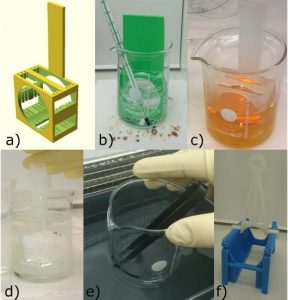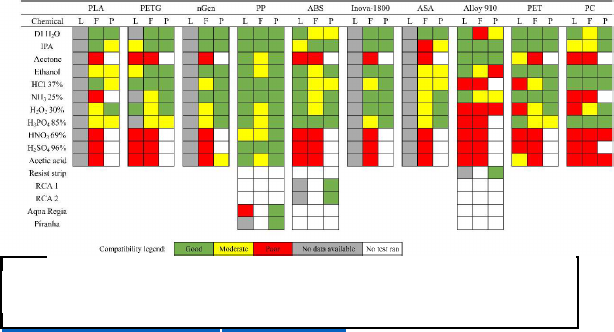 Many scientists are discovering that 3D printing is an effective, inexpensive way to make certain kinds of lab equipment, such as reactors, microscopes and more. But when chemicals are involved, care must be taken to ensure that the additives and colorants in 3D printer filaments are compatible with those chemicals. This potential incompatibility has restricted the widespread use of 3D printing for lab equipment. A new study tested the compatibility of 10 widely available FFF plastics with solvents, acids, bases and solutions used in the wet processing of semiconductor materials.
Many scientists are discovering that 3D printing is an effective, inexpensive way to make certain kinds of lab equipment, such as reactors, microscopes and more. But when chemicals are involved, care must be taken to ensure that the additives and colorants in 3D printer filaments are compatible with those chemicals. This potential incompatibility has restricted the widespread use of 3D printing for lab equipment. A new study tested the compatibility of 10 widely available FFF plastics with solvents, acids, bases and solutions used in the wet processing of semiconductor materials.
The study, entitled “Chemical Compatibility of Fused Filament Fabrication-based 3-D Printed Components with Solutions Commonly Used in Semiconductor Wet Processing,” can be accessed here. The savings amassed by 3D printing lab equipment are significant – the researchers note that 3D printing can reduce costs by 90-99% compared to conventionally produced equipment. Most 3D printing so far, however, has been limited to equipment without strict chemical compatibility standards or the use of known reagent-grade materials.
“As the exact chemical formulation of low-cost commercial 3-D printing filaments (as well as additive such as plasticizers and colorants) is proprietary and thus chemical compatibility of printed parts is unknown, there has been no significant 3-D printing use in more challenging laboratory environments, such as those of clean rooms used for semiconductor processing,” the researchers state.
Even basic equipment in clean rooms is expensive, so there is a huge opportunity to save money through 3D printing. In addition, a great deal of time in clean rooms is spent overcoming equipment limitations, as the equipment is designed to serve a wide range of research purposes instead of the optimum for every process. 3D printing equipment for individual purposes could not only reduce cost, but improve the output of experiments.
In the study, 10 different common 3D printing polymers were immersed in a range of common cleanroom chemicals for one week. After both surface and vacuum drying, mass and dimension changes were observed. Those results were then compared to chemical compatibility information available in literature for the pure plastic that correlates to the main component of the filament. The plastics tested were:
- PLA
- ABS
- PETG
- Eastman Amphora AM3300-based nGen
- Amphora 1800-based Inova-1800
- PP
- ASA
- taulman3D Alloy 910
- PET
- PC
Pieces of virgin polymer were tested, as were rectangular 3D printed objects. The results showed that virgin polymers were overall less resistant to the solutions than the 3D printed samples.
“The results for the materials for which compatibilities have been reported in the literature were mostly in line with the reported compatibility,” the researchers state. “Therefore, the additives and antioxidants used in 3-D printing filaments do not significantly impair their chemical properties compared to virgin polymers. All case studies were successful showing no loss of dimensional stability from the relatively extreme chemical environments.”
3D printed PP was the most promising material for various chemical environments, according to the researchers, but more common (for now 3D Printing) materials such as ABS and Alloy 910 also showed resistance to a wide range of chemicals. The best way to avoid unknown contaminants, they add, is to use uncolored filament.
The results are promising, but the researchers note that further study is needed to fully ascertain whether 3D printed labware is suitable for work such as semiconductor processing. There is great potential in using 3D printing for labware overall, however. It can reduce the risk of damaging samples by ensuring that tools are tailor-made for each specific sample size. They also reduce the need for using excess amounts of chemicals, in turn reducing processing costs and risk of injury.
Authors of the paper include Ismo T.S. Heikkinen, Christoffer Kauppinen, Zhengjun Liu, Sanja M. Asikainen, Steven Spoljaric, Jukka V. Seppälä, Hele Savin, and Joshua M. Pearce.
Discuss this and other 3D printing topics at 3DPrintBoard.com or share your thoughts below.
Subscribe to Our Email Newsletter
Stay up-to-date on all the latest news from the 3D printing industry and receive information and offers from third party vendors.
You May Also Like
Profiling a Construction 3D Printing Pioneer: US Army Corps of Engineers’ Megan Kreiger
The world of construction 3D printing is still so new that the true experts can probably be counted on two hands. Among them is Megan Kreiger, Portfolio Manager of Additive...
US Army Corps of Engineers Taps Lincoln Electric & Eaton for Largest 3D Printed US Civil Works Part
The Soo Locks sit on the US-Canadian border, enabling maritime travel between Lake Superior and Lake Huron, from which ships can reach the rest of the Great Lakes. Crafts carrying...
Construction 3D Printing CEO Reflects on Being Female in Construction
Natalie Wadley, CEO of ChangeMaker3D, could hear the words of her daughter sitting next to her resounding in her head. “Mum, MUM, you’ve won!” Wadley had just won the prestigious...
1Print to Commercialize 3D Printed Coastal Resilience Solutions
1Print, a company that specializes in deploying additive construction (AC) for infrastructure projects, has entered an agreement with the University of Miami (UM) to accelerate commercialization of the SEAHIVE shoreline...































